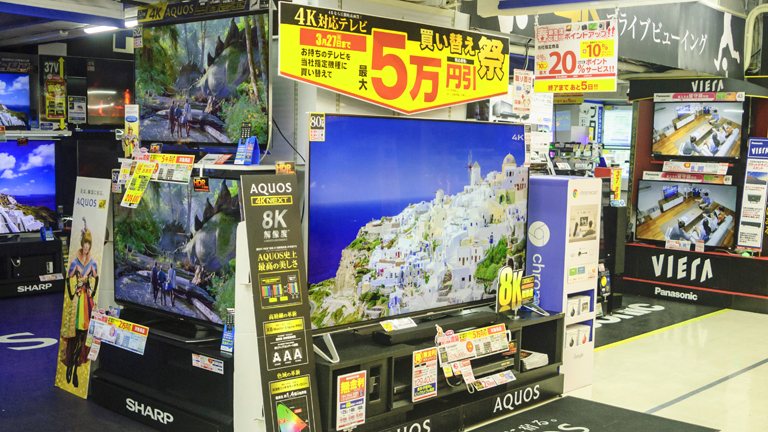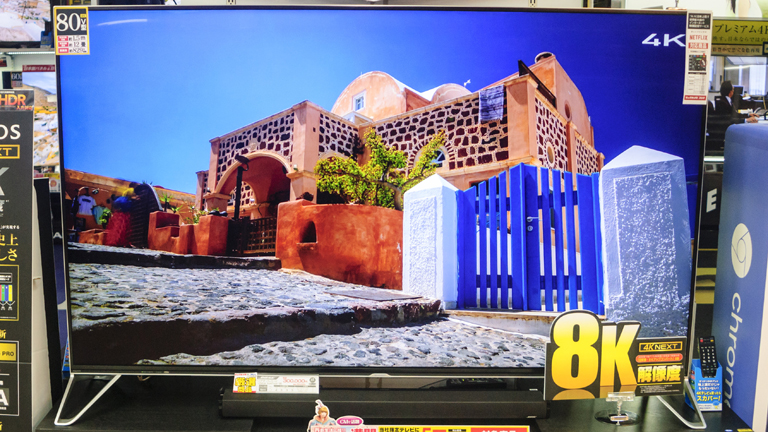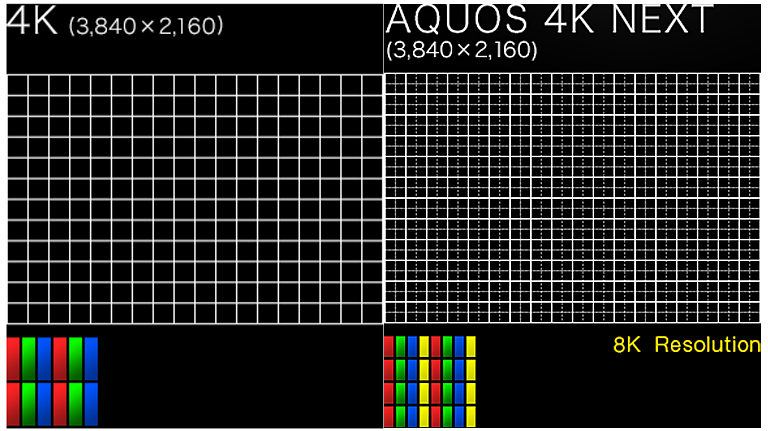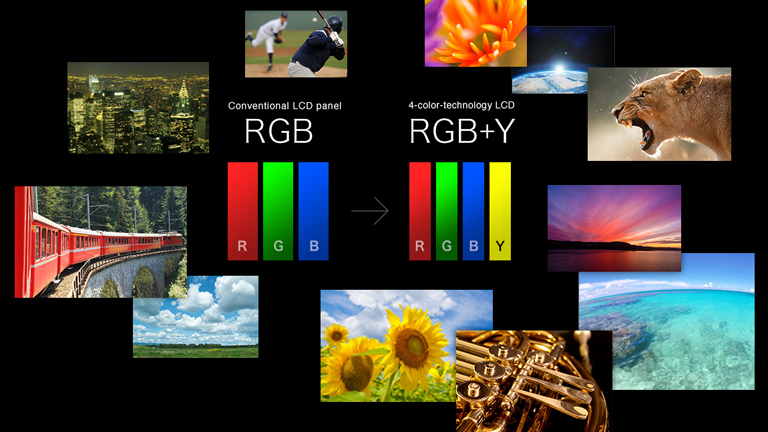
While the TV industry is trying to push 4K definition as a reason to upgrade your existing HD setup here in Europe, in Japan since 2015 Sharp has been pushing its first 8K TVs: the LV-85001 for the professional market at 16,000,000 yen (around 102,417 GBP), and the LC-80XU30 for the consumer market at the average price tag of 1,836,438 yen (around 11,755 GBP).
We're guessing that to the majority of people this is slightly annoying news - after all, many will still be using a Full HD, 1080p TV, while those who have upgraded to 4K will have only done so recently. The news that Sharp is starting to introduce 8K televisions will irk all but the most affluent tech enthusiasts. Before we go crazy though, let's actually see what this technology is really about, and also how it works.
8K is on the market already! Really?
At the launch of these 8K sets last year, many sites worldwide covered the news, including T3 sister site TechRadar, however despite the apparent massive leap forward in tech, no critical acclaim followed the announcement. In addition, no demo in any commercial venues (especially here in the West) was undertaken, so in general nobody gave much importance to the news.
Why?
Simple, there is not yet any 8K footage around to show off what these televisions can do. No broadcaster or streaming service worldwide yet delivers content in 8K, and no physical media format is yet on the market that can hold 8K content. For example, Ultra HD 4K Blu-ray players and Ultra HD Blu-ray discs are only just hitting store shelves right now, let alone 8K.
So these 8K sets are ridiculously expensive and obsolete on arrival then? Well, in many ways, yes. No one can afford them and no content exists commercially to play on them. To write these off however would be doing a massive injustice to Sharp, as the process of how they got a functioning 8K unit out so early is remarkable.
As we are fascinated with new tech and, crucially, how new technology works, we decided to take a closer look. The results are impressive to say the least.
Back to basics

Let's first go back to basics though. First of all, 8K refers to the horizontal resolution in the order of 8,000 pixels, forming total image dimensions of 7,680 x 4,320. Right now, in Japan, this resolution is grouped under the same 'UHDTV' i.e. Ultra High Definition Television naming that 4K is being marketed with here in the West.
The name may sound familiar due to the FULL HD term (1080p) that is, at the moment, in most people's homes. This, of course, technically stands for 1080 progressive or interpolated lines, forming total image dimensions of 1,980 x 1,080. While the upcoming 4K nomenclature stands for 3,840 pixels x 2,160 pixels in progressive mode (2016p).
So, simply put, 8K differs - on the technological side - from HD TVs by a factor of 16x times the resolution (in pixels). That number, 16, really hammers home the fidelity jump delivered by these sets.
Sign up to the T3 newsletter for smarter living straight to your inbox
Get all the latest news, reviews, deals and buying guides on gorgeous tech, home and active products from the T3 experts
It is so much of a jump in fact, that it gets close to IMAX detail level, which when partnered with stunning 22.2 surround sound, is labeled by NHK (Japan's equivalent of the BBC) as 'Super Hi-Vision' in Japan. Super Hi-Vision necessitates a data mole so huge (500 Mbps) that even today NHK are struggling to deliver such a heavy format easily (at 120 Hz!). Right now it isn't too much of an issue, however in two years this will be the standard used to broadcast the 2020 Olympic Games in Tokyo, so progress needs to be made. NHK has also stated that it believes the broadcasting of the Olympic Games in this super high-fidelity format, will be the catalyst to see it proliferate worldwide.
And this is the reason Sharp have been working on this new super high-fidelity, 8K technology since 2007. Sharp, who manufacture panels for their own brand of televisions, as well as for others such as Sony, recognised the need to master 8K early and have since focussed its R&D and financial assets to reach this aim. Now while they have succeeded in creating these 8K panels, they have done so not without troubled consequences and, to put it bluntly, some real high-level technomancy.
Indeed, since the end of the last decade Sharp has been reported to have lost 1.2 trillion yen ($10.76 billion). Plus their position against other LCD rivals, which in the meantime have lowered their prices and now prevail in the West, has left Sharp with no money to refund not one, but two bank-led bailouts given in 2012.
What compounds this further is that Sharp last year posted a massive net loss of $918 million, that reflected in a stock market crash, taking its unit price from 735 to 135.
Since then, Hon Hai Precision Industry (better know in the west as Foxconn) last month bought two thirds of Sharp's stock for 389 billion yen ($3.44 billion).
So, was it worth it?

We will get to how Sharp managed to get a 4K TV to display 8K content in a minute, but first here is my hands and eyes on impression.
After testing the pair of 8K TVs for almost an hour, what you really notice is not so much the quality of the image in terms of fidelity (at least not at the moment because, as I said above, there isn't any 8K native footage yet) but the quality of the color gamut is STUNNING.
Of course the difference is more clear on the professional model than the consumer panel, but in general you can see the difference on the refraction of the light on or through the materials (example: on water, clouds, leafs) and the saturation of every single color (red and blue are especially impressive).
And for me, after spending some quality time with these panels, this is what 8K will be all about for many. Sure, there will be an increase in sharpness, however to the human eye, the real big wow moment will come from the increase in colour gamut quality. The quality of the image is super also, but compared to 4K footage (already seen all around Tokyo) sincerely there is not at the moment any major difference.
Probably in one or two years (as soon as NHK masters the delivery of this new format, especially at a domestic level) then the difference between 4K and 8k will be greater and more pronounced.
So, for now, the Professional LV-85001 Sharp TV seems more like a benchmark for the company to mark its superiority on the technology field against its rivals in terms of R&D and know-how.
High-level technomancy

Now this is where things get interesting. The consumer LC-80XU30, even if labeled an 8K TV, is in reality a 4K TV!
Say what?
Yep, despite being displayed with an 8K tag, inside the actual buyer catalogue it is explained - in detail (and in japanese, but luckily my friends I am a master of the double kanji) - that it's actually a panel running Quattron PRO technology (described below) under the label '4K next', which is able to display an 8K resolution thanks to some clever engineering.
That '4K next' tag reminds us of the much-used 'HD ready' logo that many TVs had when the true Full HD TVs were still too expensive.
So how does a 4K TV display an 8K resolution? Here comes the science!
Sharp's R&D department, when developing its LED panels in the 2000s, registered and patented what it called 'Quattron' technology (later to become 'Quattron Pro'), in which the usual RGB pixel (red, green and blue) was divided further to include yellow, becoming a RGBY panel. The reason the company did this - according to Sharp, of course - is that it is easier to recreate through green and the yellow more luminance peaks, thereby generating a better detail in the overall picture (on our normal RGB TVs only the green colour delivers the luminance).
Quattron Pro technology doesn't just add in yellow to panel image construction, but also divides every pixel pushed into two sub pixels. In terms of the consumer 4K panel (a 3,840 x 2,160 resolution screen), when built with the 'Quattron Pro' technology, you therefore find that the image luminance is also doubled. So the luminance peaks are recreated not only from the RGB trio, but also the BYR trio (blue, yellow and red), with black and white dealt with in just a single pixel each time.
And this is why they can brand this panel under the '4K next' tag and advertise it as an 8K panel - technically, with the Quattron Pro technology, as each pixel is divided into two sub-pixels, the panel can actually display 66 million subpixels, a whopping 42 million more than 4K TVs. Basically, instead of packing in more pixels, they've split the panel's existing pixels.

But why not just add in more pixels, right? Why force a 4K TV through clever engineering to work as an 8K TV?
Simple, the cost of a real 8K TV currently sits at $133,000.
$133,000 is obviously too expensive to take to the mass market and is ridiculously inaccessible to the ordinary person. Sharp knows that and, wanting to recoup years of high-end R&D expenditure, has taken this avantgarde technology to market now, hoping that people will be more prone to buy its panels than others because it is already prepared for the 8K future.
The take-away from all of this? The LC-80XU30 is doubtless the new flagship in the consumer TV market. It has already scooped up a series of tech awards in Japan and probably will open for Sharp a new dominance in the 4K and 8K markets.
So, 8K is here - kind of - and if you really, really wanted to you could go out and purchase a TV set right now. Sharp has really put a marker down in the sand and seems very well placed in the 4K and 8K market too. However, the reality is that it will be years before 8K goes mainstream and if you have yet to upgrade to 4K, or have recently upgraded to 4K and are worried about your new purchases becoming rapidly obsolete, then you shouldn't really sweat.
You've got plenty of time, Sharp is just there remarkable early.
LC-80XU30 specs

Resolution: 3,840 x 2,160
3D : Yes
Watt: 498W
Weight: 59KG
Amp: digital
65 W (10W+10W+10W+10W+25W)
Speakers: Tweeter x2, Midrange x2, Subwoofer x2
THX 4K Display
HDMI:4
Analog in: 1
headphone: 1
LAN: 1
PC: 1
Bluetooth: yes
HomeNetwork: yes
AQUOS
Internet AQUOSCITY
THX 4K
T3.com is one of the UK's leading consumer lifestyle websites, visited by over 10 million people every month. You can follow us on Twitter, Facebook and Instagram. We present products in helpful buying guides and carefully curated deals posts across style, living, auto, smart home, watches, travel, fitness and more. We also have a monthly magazine which you can buy in newsagents or subscribe to online – print and digital versions available.
-
 3 overrated shoulder exercises, according to a fitness expert (and what to do instead)
3 overrated shoulder exercises, according to a fitness expert (and what to do instead)Sculpt 3D shoulders whilst minimising injury with these three alternative exercises
By Bryony Firth-Bernard Published
-
 Polar’s new subscription feature lands in the shadow of Garmin’s Connect+ rollout
Polar’s new subscription feature lands in the shadow of Garmin’s Connect+ rolloutPR genius or timing disaster? Polar’s new Fitness Programme adds adaptive training to its ecosystem
By Matt Kollat Published
